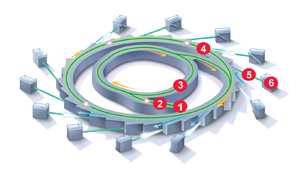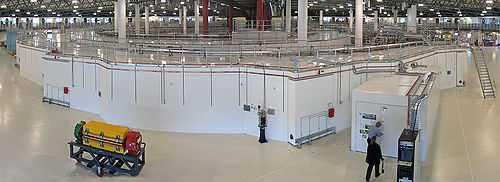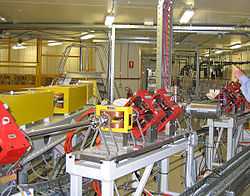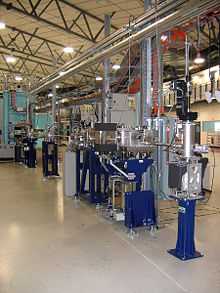Australian Synchrotron

The Australian Synchrotron is a 3 GeV synchrotron radiation facility built in Melbourne, Victoria and opened on 31 July 2007.[1][2] The circular building was designed by Architectus in conjunction with Thiess,[3] while the lattice design was performed substantially by Professor John Boldeman. The Synchrotron building is located in Clayton near the Monash University Clayton Campus.
The Australian Synchrotron is a light source facility (in contrast to a collider). It uses particle accelerators to produce a beam of high energy electrons which are placed within a storage ring that circulates the electrons to create synchrotron light. The light is directed down separate beamlines at the end of which may be placed a variety of experimental equipment contained within the endstations.
Accelerator systems[4]

Electron gun
The electrons used to provide the synchrotron light are first produced at the electron gun, by thermionic emission from a heated metal cathode. The emitted electrons are then accelerated to an energy of 90 keV (kilo-electron volts) by a 90 kilovolt potential applied across the gun and make their way into the linear accelerator.
Linear accelerator
The linear accelerator (or linac) uses a series of RF cavities, operating at a frequency of 3 GHz, to accelerate the electron beam to an energy of 100 MeV, over a distance of around 15 metres. Due to the nature of this acceleration, the beam must be separated into discrete packets, or 'bunches'. This bunching process is done at the start of the linac, using several 'bunching' cavities. The linac can accelerate a beam once every second. Further along the linac quadrupole magnets are used to help focus the electron beam.

Booster synchrotron
The booster is an electron synchrotron which takes the 100 MeV beam from the linac and increases its energy to 3 GeV. The booster ring is 130 metres in circumference and contains a single 5-cell RF cavity (operating at 500 MHz) which provides energy to the electron beam. Acceleration of the beam is achieved by a simultaneous ramping up of the magnet strength and cavity fields. Each ramping cycle takes approximately 1 second (for a complete ramp up and down).
Storage ring
The storage ring is the final destination for the accelerated electrons. It is 216 metres in circumference and consists of 14 nearly identical sectors. Each sector consists of a straight section and an arc, with the arcs containing two dipole 'bending' magnets each. Each dipole magnet is a potential source of synchrotron light and most straight sections can also host an insertion device, giving the possibility of 30+ beamlines at the Australian Synchrotron. Two of the straight sections are used to host the storage ring 500 MHz RF cavities, which are essential for replacing the energy that the beam loses through synchrotron radiation. The storage ring also contains a large number of quadrupole and sextupole magnets used for beam focusing and chromaticity corrections. The ring is designed to hold 200 mA of stored current with a beam lifetime of over 20 hours.
Vacuum systems
The electron beam is kept within a very high vacuum at all times during the acceleration process and within the storage ring. This vacuum is necessary as any beam collisions with gas molecules will quickly degrade the beam quality and reduce the lifetime of the beam. The vacuum is achieved by enclosing the beam in a stainless steel pipe system, with numerous vacuum pump systems continually working to keep the vacuum quality high. Pressure within the storage ring is typically around 10−13 bar (10 nPa).
Control system
Each digital and analogue I/O channel is associated with a database entry in a customised distributed open source database system called EPICS (Experimental Physics and Industrial Control System). The condition of the system is monitored and controlled by connecting specialised GUIs to the specified database entries. There are about 45,000 database entries (also known as process variables), most of which relate to the physical I/O. About 35,000 of these are permanently archived at intervals ranging from milliseconds to minutes. Some high level control of the physics-related parameters of the beam is provided through MATLAB which also provides data analysis tools and an interface with a computerised model of the accelerator. Personnel and equipment protection is achieved through the use of PLC-based systems, which also transfer data to EPICS. The Beamlines also use EPICS as the basis for their control.
Beamlines and experimental endstations

- Imaging and medical therapy
- Infrared spectroscopy
- Micro spectroscopy
- Protein crystallography
- Powder diffraction
- Small and wide angle scattering
- Soft X-ray spectroscopy
- X-ray absorption spectroscopy
Management and governance issues
In 2009, the Australia Synchrotron Director, Professor Robert Lamb, was dismissed,[5] resulting in widely publicised tension between the Synchrotron board, the Science Advisory Committee (the SAC) to the Australian Synchrotron and staff at the facility. This in turn resulted in a number of resignations by both SAC and facility staff[6][7][8][9]
In February 2011, after an unsuccessful series of attempts to recruit a Director, Professor Keith Nugent, a board member, was appointed as a part-time Director of the Australian Synchrotron. A new position of Chief Operating Officer, responsible for operational management of the facility, was created and filled by the previously acting director, Dr George Borg.[10]
In May 2011, The Sunday Age reported that the synchrotron could be closed in 2012 after neither the Victorian state and the Federal governments would commit to ongoing funding of the research. On 15 September 2011 The Australian reported "Synchrotron experts 'may leave' "..."due to job security uncertainty" after an FOI brief to the new secretary of the Department of Innovation, Industry, Science and Research was obtained [11] In late March 2012, funding was secured after both the federal and Victorian governments agreed to $95 million funding arrangement.[12] In April 2012, the deal funding the synchrotron has required the facility to cut spending by at least 10 per cent according to the Director.[13] In July 2012 a number of staff positions were cut.[14] The director, Professor Keith Nugent, after 18 months has announced his resignation to coincide with the ANSTO takeover and further staff cuts.[15]
See also
References
- ↑ Official Opening webcast timetable & archive site, 31 Jul 2007
- ↑ "Scientists to unveil monster synchrotron", ABC News, 31 July 2007
- ↑ Architectus and Thiess to Design Australian Synchrotron
- ↑ "Australian Synchrotron Machine Fact sheet".
- ↑ Egan, Carmel (8 November 2009), "Stinkatron: chaos at the top", The Age (Melbourne), archived from the original on 16 January 2010, retrieved 1 Jan 2010
- ↑ Egan, Carmel (29 November 2009), "Scientists' rebellion to cripple synchrotron beam", The Age (Melbourne), archived from the original on 1 January 2010, retrieved 1 Jan 2010
- ↑ Egan, Carmel (6 December 2009), "Seven scientists at synchrotron issue ultimatum", The Age (Melbourne), archived from the original on 9 January 2010, retrieved 1 Jan 2010
- ↑ "Scientists walk out on Synchrotron", ABC News, 11 December 2009, archived from the original on 17 January 2010, retrieved 1 Jan 2010
- ↑ Egan, Carmel (13 December 2009), "Out of sync", The Age (Melbourne), retrieved 1 Jan 2010
- ↑ Australian Synchrotron announces senior appointments, 1 Mar 2010, retrieved 9 May 2011
- ↑ Lane, Bernard (15 Sep 2011), "Synchrotron experts 'may leave'", The Australian, retrieved 16 Sep 2011
- ↑ Luke Hopewell (28 March 2012). "Deal sees Synchrotron live on and on". ZDNet (CBS Interactive). Retrieved 28 March 2012.
- ↑ Lane, Bernard (4 Apr 2012), "Rescued science facility must trim spending", The Australian, retrieved 6 Apr 2012
- ↑ E. Finkel (19 July 2012), "Stability at Last for Australian Synchrotron?", Sciencemag, retrieved 20 July 2012
- ↑ Bernard Lane (21 Aug 2012), "Synchrotron loses director, gains new manager", The Australian, retrieved 22 Aug 2012
External links
| Wikimedia Commons has media related to Australian Synchrotron. |
- Australian Synchrotron website
- Facility Status software - updated every minute
- Lightsources - website about the world's synchrotrons
- Deconstruction of Australian Synchrotron in symmetry magazine (Fermilab/SLAC), May 2006